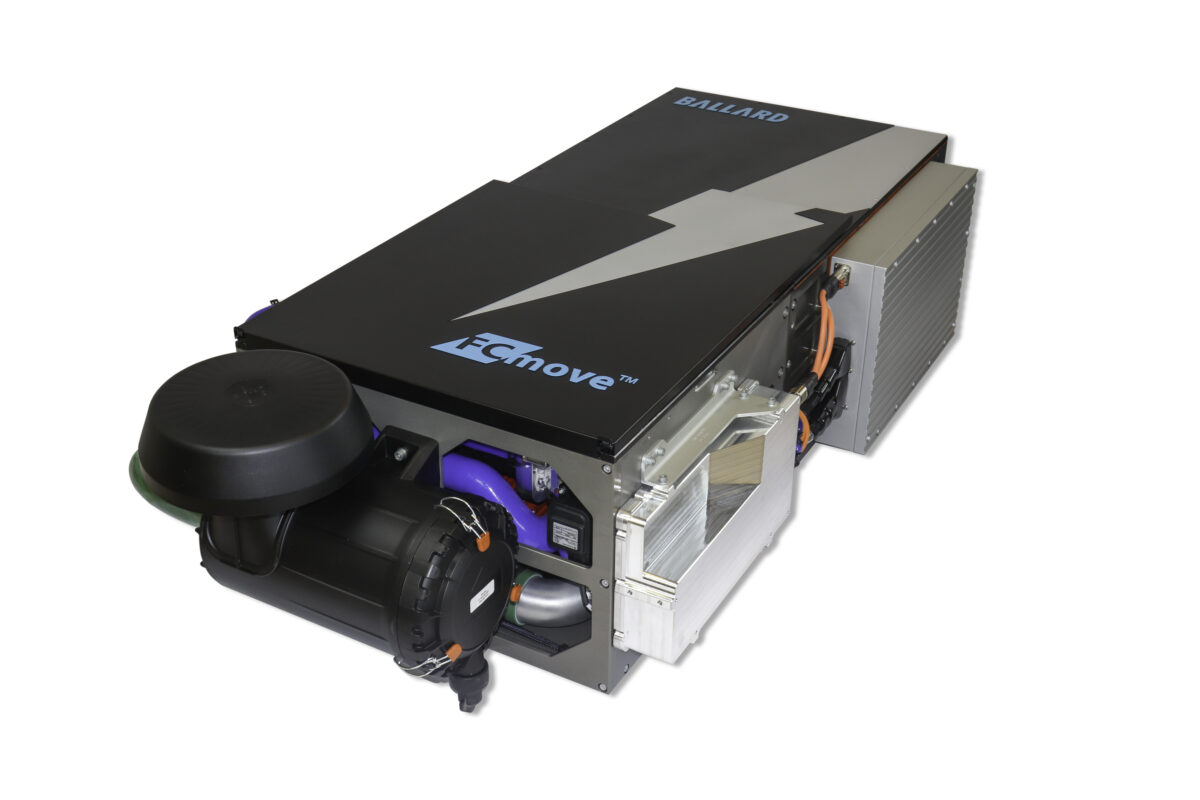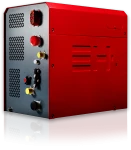Browse fuel cell systems from leading suppliers on our marketplace!
Fuel cell system is a term used to describe the entire system environment used to make a fuel cell, or fuel cell stack, work properly. While a fuel cell is a device that converts the chemical energy stored within the fuel into electricity through an electrochemical process, the various fuel cell systems explained here additionally encompass all implements enabling this process to take place.
The basic design principle will determine the make-up and components used. For example a solid oxide fuel cell system will be different from a pem fuel cell system.
Fuel cell systems are adapted to the specific use case or application scenario. For example, A residential fuel cell system will look entirely different than a system used to integrate fuel cell power into a city bus. This is because fuel cell systems for homes require a variety of different implements for operation and safety than e.g. those used in hydrogen mobility solutions.
Basic principles of a fuel cell system
The basic principle behind a fuel cell is the production of electricity through the controlled reaction of fuel and an oxidant, such as oxygen or air. The fuel cell system enables the fuel (typically hydrogen), and the oxidant to be supplied into opposite sides of a fuel cell stack, which is made up of a series of individual fuel cells. The fuel cells are separated by thin, electrically conductive plates, known as bipolar plates. As the fuel and oxidant flow through the stack, they react at the surface of the fuel cells to produce electricity, water, and heat.
The electricity generated by the fuel cell stack is collected by electrodes and conducted through electrical wires to the load, which can be used to power a variety of devices or systems. The water produced by the reaction is typically collected and recycled back into the hydrogen fuel cell system, while the heat is usually dissipated through a cooling system to prevent overheating of the fuel cells.
Important subsystems of a fuel cell system
- Fuel cell stack: The fuel cell stack is the core component of the fuel cell system, and is responsible for generating electricity through the electrochemical reaction of fuel and oxidant. The fuel cell stack is typically composed of a series of individual fuel cells, which are separated by bipolar plates.
- Fuel supply system: In hydrogen fuel cell systems, the fuel supply system is responsible for delivering the fuel to the fuel cell stack. This may include a fuel tank, a fuel pump, and a gas regulator to control the flow and pressure of the fuel.
- Oxidant supply system: The oxidant supply system is responsible for delivering the oxidant (typically oxygen or air) to the fuel cell stack. This may include an air compressor, an oxygen tank, and an air purification system to remove impurities from the oxidant.
- Cooling system: The cooling system is responsible for removing the excess heat generated by the fuel cell stack during the electrochemical reaction. This may include a heat exchanger, a pump, and a cooling fluid to circulate through the fuel cell stack.
- Electrical system: The electrical system is responsible for collecting the electricity generated by the fuel cell stack and delivering it to the load. This may include electrical wiring, connectors, and power conditioning equipment to optimize the electrical output of the fuel cell system.
Fuel cell system components
Their are 5 main components of a fuel cell systems. This includes fuel cell stack, fuel tank, fuel pump, gas regulator and air compressor.
- Fuel cell stack: The fuel cell stack is the core component of the fuel cell system, and is responsible for generating electricity through the electrochemical reaction of fuel and oxidant. The fuel cell stack is typically composed of a series of individual fuel cells, which are separated by bipolar plates.
- Fuel tank: The fuel tank in hydrogen fuel cell systems is responsible for storing and delivering the fuel. The fuel tank may be a high-pressure tank, a cryogenic tank, or a solid-state storage system, depending on the system type and the specific application.
- Fuel pump: The fuel pump is responsible for delivering the fuel from the fuel tank to the fuel cell stack at the appropriate flow rate and pressure. The fuel pump may be a high-pressure pump, a cryogenic pump, or a diaphragm pump, depending on the type of and specific application.
- Gas regulator: The gas regulator is responsible for controlling the flow and pressure of the fuel and oxidant gases as they enter the fuel cell stack. The gas regulator may be a high-pressure regulator, a cryogenic regulator, or a mass flow controller, depending on the type of fuel cell system and the specific use case.
- Air compressor: The air compressor is responsible for delivering the oxidant (typically oxygen or air) to the fuel cell stack

Example: Fuel cell system by Ballard Power Systems
Key performance criteria’s
Their are six key performance criteria’s of a state of the art fuel cell system.
- Efficiency: The fuel cell system efficiency is a measure of the amount of electricity that is generated by the system compared to the amount of fuel that is consumed. A state-of-the-art fuel cell system should have a high efficiency, typically in the range of 40-60%.
- Power density: The power density is a measure of the amount of electricity that the system can generate per unit of volume or mass. A typical system should have a high-power density typically in the range of 0.5-1.5 kW/L or kW/kg.
- Durability: The durability of a fuel cell system is a measure of the system’s ability to withstand wear and tear over time. It should generally have high durability, with long service life and low maintenance requirements.
- Fuel flexibility: The fuel flexibility is a measure of the system’s ability to operate on a variety of fuels. A state-of-the-art fuel cell system should be able to operate on multiple fuels, such as hydrogen, natural gas, and biogas.
- Response time: The response time is a measure of how quickly the system can respond to changes in load or fuel availability. A fast response time, typically within a few seconds, is highly desirable.
- Cost: The cost of a fuel cell system is a key performance criterion, as it determines the economic viability of the system. The cost should be competitive, both in terms of upfront capital costs and ongoing operating costs.
Technical attributes
Technical attributes play a crucial role when purchasing and integrating a fuel cell system. There are mainly seven different type of attributes that are important for a fuel cell system
- Fuel type: The type of fuel that the system is designed to use is an important technical attribute, as it determines the fuel supply system and fuel cell stack that are required. For example, a hydrogen fuel cell system will require a different fuel supply system and fuel cell stack than a system that operates on natural gas or biogas.
- Operating temperature: The operating temperature of the system is an important technical attribute, as it determines the required stack type and fuel cell cooling system type. For example, a system that operates at high temperatures may require a solid oxide fuel cell stack and a more robust cooling system, while a system that operates at low temperatures may be able to use a polymer electrolyte membrane fuel cell stack and a simpler cooling system.
- Output power: The output power is of course a fundamentally important technical attribute, as it determines the size and scale of the system. The output may be specified in terms of watts, kilowatts, or megawatts, depending on the size of the load that the system is intended to power.
- Response time: The response time of a fuel cell system is an important technical attribute, as it determines the system’s ability to respond to changes in load or fuel availability. A system with a fast response time may be preferred for applications that require a quick response, such as backup power or peak shaving.
- Efficiency: The efficiency of a fuel cell system is an important technical attribute, as it determines the amount of electricity that can be generated from a given amount of fuel. A system with high efficiency may be preferred for applications that require a high level of energy conversion efficiencies, such as stationary power or transportation.
- Durability: The durability of a fuel cell system is an important technical attribute, as it determines the system’s ability to withstand wear and tear over time. A system with high durability may be preferred for applications that require a long service life or low maintenance requirements.
- Fuel flexibility: The fuel flexibility of a fuel cell system is an important technical attribute, as it determines the system’s ability to operate on a variety of fuels. A system with high fuel flexibility may be preferred for applications that require the ability to operate on multiple fuels, such as backup power or combined heat and power systems.
Fuel cell system efficiency
The efficiency of a fuel cell system is typically measured as the ratio of the electrical output of the system to the chemical energy input of the fuel. This is commonly expressed as a percentage, with higher percentages indicating higher efficiency.
There are several different ways to measure the efficiency of a fuel cell system, i.e. gross electrical efficiency, net electrical efficiency, fuel utilization efficiency and energy efficiency.
- Gross electrical efficiency is a measure of the efficiency of the fuel cell stack itself and is calculated as the ratio of the electrical output of the fuel cell stack to the chemical energy input of the fuel.
- Net electrical efficiency is a measure of the overall efficiency of the fuel cell system, including all of the subsystems and auxiliary components. It is calculated as the ratio of the electrical output of the system to the chemical energy input of the fuel, minus the energy losses from the subsystems and auxiliary components.
- Fuel utilization efficiency is a measure of the amount of fuel that is converted by the system and is calculated as the ratio of the chemical energy output of the fuel cell stack to the chemical energy input of the fuel.
- Energy efficiency is a measure of the overall efficiency of the fuel cell system, including both the electrical output and the heat output of the system. It is calculated as the ratio of the useful energy output (electrical and thermal) to the chemical energy input of the fuel.
It is important to note that the efficiency of a fuel cell system can be affected by several factors, including the type of fuel cell technology, the operating temperature, the load demand, and the quality of the fuel and oxidant. As a result, the measured system efficiency may vary depending on the specific operating conditions.
Last but not least, everything in connection with fuel cell system manufacturing is also a factor in the picture of overall efficiency. Production of a fuel cell power system must not incur far higher costs, e.g. by way of exotic materials used, than the efficiency parameters of the system will likely save over time during its use. This means that system efficiency will be subject to different considerations e.g. for stationary fuel cell power systems designed to be constantly operating, compared to e.g. hydrogen mobility applications which are only operating for comparatively short periods over their lifetime.
Safety measures
There are a number of safety measures that are typically taken in the design of a fuel cell system to ensure operating safety. These measures may include:
- Pressure relief valves are used to prevent the build-up of excessive pressure within the system, which could lead to rupturing of components. The pressure relief valves are typically designed to open at a specific pressure threshold, allowing excess gas to be vented to the atmosphere.
- Overpressure protection is used to prevent the fuel cell system from operating at pressures that are outside of its design limits. This may include sensors and control systems that monitor the pressure within the system and shut off the fuel supply if the pressure exceeds a certain threshold.
- Overcurrent protection is used to prevent the system from operating at currents that are outside of its design limits. This may include sensors and control systems that monitor the current within the system and shut off the fuel supply if the current exceeds a certain threshold.
- Thermal protection is used to prevent the fuel cell system from overheating, which could damage the fuel cells or cause a fire. This may include thermal sensors and control systems that monitor the temperature within the system and shut off the fuel supply if the temperature exceeds a certain threshold.
- Gas leakage detection is used to detect and prevent the release of hazardous gases. This may include sensors and alarms that are designed to detect the presence of hydrogen or other flammable gases in the surrounding environment.
- Safety interlocks are used to prevent the fuel cell system from operating if certain safety conditions are not met. For example, a safety interlock may be used to prevent starting if the fuel tank is not properly sealed or if the fuel cell stack is not properly cooled.
Hydrogen fuel quality
The quality of the fuel that is used in a hydrogen fuel cell system can have a significant impact on the performance of the system. In general, higher-quality hydrogen leads to better performance, while lower-quality hydrogen may result in reduced performance or even damage to the system. The factors that can affect the quality of hydrogen fuel are mentioned below.
- Purity: The purity of hydrogen refers to the concentration of impurities in the gas. Higher purity hydrogen is typically preferred for fuel cell systems, as impurities can interfere with the electrochemical reactions that take place within the fuel cell stack.
- Pressure: The pressure of hydrogen is an important factor in the performance of a fuel cell system, as it determines the rate at which the hydrogen is delivered to the fuel cell stack. Higher-pressure hydrogen may be preferred for some systems, as it can increase the flow rate of the gas and improve the performance of the system.
- Temperature: The temperature of hydrogen can affect the performance of a fuel cell system, as it determines the energy required to vaporize the gas and the rate at which the hydrogen is delivered to the fuel cell stack. In some fuel cell systems, higher-temperature hydrogen may be preferred, as it can increase the flow rate of the gas and improve the performance of the system.
- Moisture: The presence of moisture in hydrogen can affect the performance of a fuel cell system, as it can interfere with the electrochemical reactions that take place within the fuel cell stack. High-purity hydrogen with low moisture content is typically preferred for fuel cell systems.
- Contaminants: Hydrogen fuel contamination by e.g. particles or gases, can affect the performance of a fuel cell system. High-purity hydrogen with low levels of contaminants is typically preferred, and in some cases a basic requirement for functionality.
To ensure optimal performance, it is important to use high-quality hydrogen in a fuel cell system. This may require the use of purification and drying systems to remove impurities and moisture from the hydrogen, as well as filtration systems to remove contaminants.
Use cases and applications
Fuel cell systems are a key technology in the hydrogen economy, offering a clean and efficient means of generating electricity and heat from hydrogen. There are a wide range of use cases for fuel cell systems in the hydrogen economy, ranging from stationary applications such as power generation and combined heat and power (CHP) systems to mobile applications such as transportation and portable power.
a) Stationary applications
Stationary fuel cell power systems are typically used for power generation and in CHP applications, where they can be used to generate electricity and heat on-site for commercial, industrial, and residential customers. Some common stationary use cases for fuel cell systems include:
- Power generation: Fuel cell systems can be used to generate electricity for the grid or for on-site consumption. This can be particularly useful for applications where a stable and reliable power supply is required, such as data centers, hospitals, and other critical infrastructure.
- CHP systems: Fuel cell systems can be used to generate both electricity and heat for on-site consumption, through a process known as combined heat and power (CHP). CHP systems can be particularly efficient, as they can capture the heat that is generated during the electricity generation process and use it for heating, hot water, or other purposes.
b) Mobile applications
Mobile fuel cell systems are typically used for transportation and portable power applications, where they can offer a clean and efficient alternative to fossil fuels. Some common mobile use cases for fuel cell systems include:
- Transportation: Fuel cell systems can be used to power vehicles, including cars, buses, trains and trucks. Fuel cell vehicles offer several advantages over traditional gasoline or diesel vehicles, including lower emissions, longer driving range, and faster refueling times.
- Portable power: Fuel cell systems can also be used to provide portable power for a wide range of applications, including military, emergency services, and recreational activities. They also offer several advantages over traditional gasoline generators, including lower emissions, longer run times, and quieter operation.
Design philosophies
The design philosophy of a fuel cell system will depend on the specific requirements and constraints of the application.
a) Scalability
Fuel cell systems can be designed to be scalable, meaning that they can be easily modified or expanded to meet changing energy needs. This can be particularly useful for applications where the energy demand is variable or uncertain, such as in the case of renewable energy systems.
b) Modularity
Fuel cell systems can also be designed to be modular, meaning that they can be composed of smaller, interchangeable components that can be easily assembled and disassembled. This can be useful for applications where the fuel cell system needs to be relocated or repurposed, as it allows the system to be easily reconfigured.
c) Standardization:
Fuel cell systems can be designed to be standardized, meaning that they are based on common, widely accepted design principles and components. This can help to reduce the cost and complexity of the system, as it allows the system to be easily integrated with other technologies and equipment
By understanding the different design philosophies and selecting the most appropriate one, fuel cell engineers can help optimize the performance and cost-effectiveness of the fuel cell system.
The design philosophy has specific relevance with respect to integration of the fuel cell system into an overall infrastructure of fuel and energy supply. For example, a fuel cell battery hybrid system is used to incorporate a buffer function for renewable energy or when using energy recuperation systems. This applies specifically to the combination of hydrogen and fuel cell technology when designing renewable energy fuel cells.
See the educational video to learn the differences between FCEV and EV
Last update: 14.07.2023






